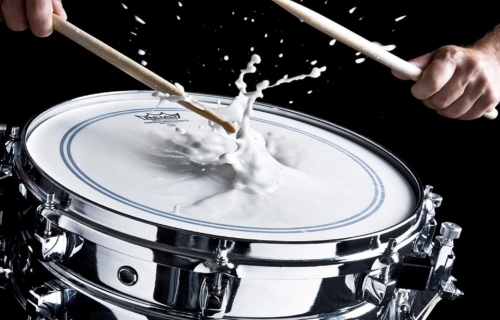The snare drum and electric guitar are often the driving force of a song despite the kick and bass being considered the foundation of a mix.
Turn down the snare drum and the congregation will feel reluctant to clap with the song.
Mic the top and bottom of the snare drum. The top mic will catch the stick hitting the drum and pick up much of the body of the snare. The bottom mic will help pick up the actual snare sound to really cut through the mix. Change the polarity of the bottom mic. Otherwise, it’s possible some phase cancellation with the two mics will occur.
The snare EQ depends a lot on the snare drum you’re drummer is using and what kind of sound you’re looking for. Mixing that thunderous snare of Def Leppard is different from mixing a punk band with a 3-inch snare drum. Match the snare sound with the song.
That being said, the snare needs some body. The low-mids are a good place to start. Don’t go too low because room is needed for the toms. The 250-450 Hz range is a good place to boost. Try a high-pass filter up to about 125-150 Hz to cut out any low rumbling.
On the top snare microphone, the stick slap is around the 1-2 kHz area. The boost amount depends on the desired sound. A boomy snare sound will need more in this range. For a thinner snare sound, trying to stay away from the ‘80s arena rock snare, cut in this range or just don’t boost as much.
On the bottom snare drum, to pick up the actual snare, boost in a higher ranger; 3-6 kHz will bring this out. This is a real test in mixing here, making sure to get the proper EQ on the top and bottom mic.
Don’t boost these frequencies in both microphones. For example, a boost of 6 kHz in the bottom mic plus a boost at the same place on the top mic will often just give the snare a big bad ring.
Speaking of big bad rings, snare drums often have lots of these. Sometimes it’s meant to be there, sometimes the drummer has no idea their drum rings like that. Decide if it adds to the overall drum mix or if it’s just an annoying ring.
Sometimes the ring goes unnoticed when the rest of the kit is played, but it’s best to find the frequency of the ring and try to eliminate it.
Remember, when trying to eliminate the ring, the overall snare sound should not be hurt. For instance, if I cut at 3 kHz because of a ring but lose the impact of the actual snare, did I actually improve the sound? This is especially true if the ring goes unnoticed behind the rest of the kit.
Should the snare be compressed? I compress it. Some don’t. The question is, how strong do we put that compressor? I like to compress the drum just in case the drummer decides to do something a little out of the ordinary. Also, in case they do some rim shots, I don’t want to have to ride the fader.
Set the compressor to a 2:1 ratio with a generous threshold with a fast attack and a slow release. If you don’t notice any huge volume differences with his playing then at least there’s a compressor backup in case something strange happens. But, with these settings, the snare isn’t over-compressed which would take away the dynamic of the drummer’s playing.
Gate? Again, yes. This can also be a good way to get rid of a ring. It also depends on the sound the band wants. I’ve put a really tight gate on snare drums and it has sounded great. But don’t take away the body of the snare by making it sound too tight and short. We want to let the drum breathe here. This is another place to play with. Turn some knobs on the gate and see what it does to the drum sound; did it help? If it did, then keep going If it makes it worse, turn them back.
Snare drums are interesting instruments; what can be very good on one snare drum, in one song might be completely wrong on another snare drum in another song. Use the above as guidelines to find what sounds best for you.
Derek Sexsmith is the media director at Creekside Church in Waterloo, Ontario, Canada. He writes on the life of a church tech at DerekSoundGuy.com.





















